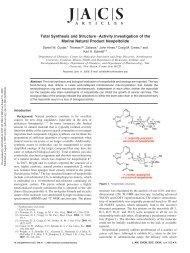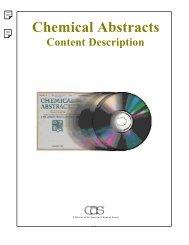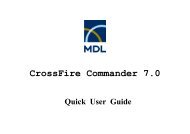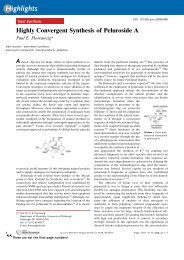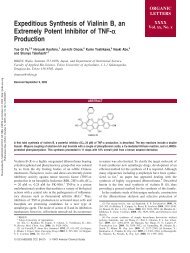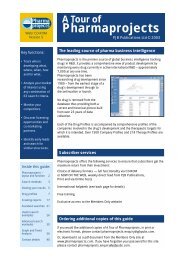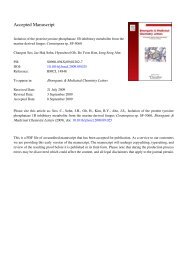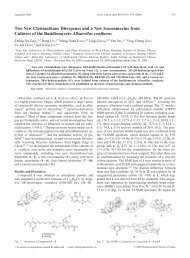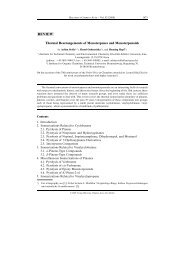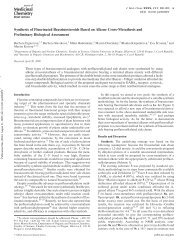Carteriosulfonic Acids A−C, GSK-3β Inhibitors from a ...
Carteriosulfonic Acids A−C, GSK-3β Inhibitors from a ...
Carteriosulfonic Acids A−C, GSK-3β Inhibitors from a ...
Create successful ePaper yourself
Turn your PDF publications into a flip-book with our unique Google optimized e-Paper software.
Downloaded by SHANGHAI INST OF ORG CHEM on August 23, 2009<br />
Published on August 21, 2009 on http://pubs.acs.org | doi: 10.1021/np900336f<br />
<strong>Carteriosulfonic</strong> <strong>Acids</strong> A-C, <strong>GSK</strong>-3 <strong>Inhibitors</strong> <strong>from</strong> a Carteriospongia sp.<br />
Malcolm W. B. McCulloch, † Tim S. Bugni, † Gisela P. Concepcion, ‡ Gary S. Coombs, § Mary Kay Harper, † Simran Kaur, §<br />
Gina C. Mangalindan, ‡ Misha M. Mutizwa, § Charles A. Veltri, † David M. Virshup, § and Chris M. Ireland* ,†<br />
Department of Medicinal Chemistry, UniVersity of Utah, Salt Lake City, Utah 84112, Marine Science Institute, UniVersity of the Philippines,<br />
Diliman 1101, Quezon City, Philippines, and Duke NUS Graduate Medical School, Singapore, 169547<br />
ReceiVed June 3, 2009<br />
Modulators of Wnt signaling have therapeutic potential in a number of human diseases. A fractionated library <strong>from</strong><br />
marine invertebrates was screened in a luciferase assay designed to identify modulators of Wnt signaling. A fraction<br />
<strong>from</strong> a Carteriospongia sp. sponge activated Wnt signaling and was subsequently shown to inhibit <strong>GSK</strong>-3, which<br />
inhibits Wnt signaling through phosphorylation of -catenin. Three novel natural products, carteriosulfonic acids A (1),<br />
B(2), and C (3), were identified as active constituents. The carteriosulfonic acids contain unprecedented 4,6,7,9tetrahydroxylated<br />
decanoic acid subunits. Their structures were elucidated through analysis of NMR data and a detailed<br />
analysis of pseudo MS 3 spectra.<br />
The Wnt signaling pathway plays major roles in controlling cell<br />
proliferation and differentiation; therefore, misregulation of the Wnt<br />
pathway has been implicated in a number of human diseases<br />
including cancer and neurodegenerative diseases. 1 The kinase <strong>GSK</strong>-<br />
3 negatively regulates mammalian Wnt signaling via phosphorylation<br />
of -catenin in the destruction complex. Upon phosphorylation<br />
of -catenin by <strong>GSK</strong>-3, -catenin is targeted and ubiquitinated<br />
by -TrCP and subsequently degraded by the proteasome. Activation<br />
of Wnt signaling leads to disheveled-mediated inhibition of<br />
<strong>GSK</strong>-3, allowing -catenin to activate transcription of Wnt/catenin<br />
responsive genes.<br />
We recently outlined a screen to identify modulators of Wnt<br />
signaling <strong>from</strong> a fractionated marine natural products library.<br />
Recently, we reported studies on bromotyrosine derivatives that<br />
activated the Wnt signaling reporter in a nonspecific manner through<br />
HDAC inhibition. 2 Herein, we report biological and chemical<br />
studies on another hit <strong>from</strong> the screen. A fraction derived <strong>from</strong> a<br />
Carteriospongia sp. was a Wnt signaling activator and yielded three<br />
new low µM inhibitors of <strong>GSK</strong>-3, carteriosulfonic acids A (1), B<br />
(2), and C (3). These natural products contain an unprecedented<br />
4,6,7,9-tetrahydroxylated decanoic acid subunit that is derivatized<br />
as an amide with taurine and further esterified at O-9 with longchain<br />
allylic-alcohol-containing fatty acid groups. The differences<br />
between 1, 2, and 3 lie in the long-chain fatty acid components.<br />
Structurally, the carteriosulfonic acids are most closely related<br />
to taurospongin A and irciniasulfonic acid B. All of these<br />
compounds contain taurine-functionalized decanoic acid subunits;<br />
however, they differ in the substitution patterns on the decanoic<br />
subunits and in the makeup of the long-chain fatty acid components.<br />
Taurospongin A was obtained <strong>from</strong> a Hippospongia sp. and<br />
exhibited activity against DNA polymerase and HIV reverse<br />
transcriptase. 3 Irciniasulfonic acid B, obtained <strong>from</strong> an Ircinia sp.,<br />
was a mixture of two related compounds that reversed multidrug<br />
resistance in KB/VJ300 cells. 4<br />
Results and Discussion<br />
Following the previously reported library screen, 2 we hypothesized<br />
that some of the Wnt signaling activators might work through<br />
inhibition of <strong>GSK</strong>-3. Thus, when an activator of Wnt signaling<br />
<strong>from</strong> a Carteriospongia sp. in the library (library code: 6CB8) was<br />
* Corresponding author. Tel: +1-801-581-8305. Fax: +1-801-585-6208.<br />
E-mail: cireland@pharm.utah.edu.<br />
† University of Utah.<br />
‡ University of the Philippines.<br />
§ Duke NUS Graduate Medical School.<br />
J. Nat. Prod. XXXX, xxx, 000 A<br />
found to inhibit <strong>GSK</strong>-3, the extract was selected for further<br />
chemical analysis.<br />
The initial approach to analyzing 6CB8 utilized the previously<br />
described automated LCMS fractionation protocol. 5,6 A onemilligram<br />
archived sample of 6CB8 was chromatographed on a<br />
monolithic C-18 column to generate 20 fractions in a 96-well plate.<br />
Screening of fractions indicated concentration of activity in well<br />
7, which eluted between 9 and 10 min. The (+) ESIMS of the<br />
active fraction revealed several sodium-containing clusters between<br />
m/z 700 and 810. An analysis to reconcile the accurate mass data<br />
with the source taxonomy yielded no known natural product<br />
candidates.<br />
NMR analysis of the active well (∼50 µg) revealed a mixture<br />
of related oxygenated fatty acid derivatives. At this stage, major<br />
substructural elements of the carteriosulfonic acids (1, 2, and 3)<br />
were elucidated by gCOSY, gHSQC, and gHMBC experiments.<br />
In order to purify and fully characterize the <strong>GSK</strong>-3 inhibitors<br />
observed in the active LCMS fractions, a scaled up extraction of<br />
the Carteriospongia sp. was conducted. A MeOH extract of the<br />
sponge was chromatographed on HP20SS resin using a gradient<br />
of 100% H2O to 75% isopropyl alcohol (IPA), followed by 100%<br />
MeOH. The 50% IPA fraction contained the same compounds<br />
observed in LCMS fraction 7. <strong>Carteriosulfonic</strong> acids A (1),B(2),<br />
andC(3) were purified on LH20 followed by RP-HPLC. The<br />
structural elucidation of 1, 2, and 3 relied on extensive 2D NMR<br />
and MS/MS analyses.<br />
10.1021/np900336f CCC: $40.75 © XXXX American Chemical Society and American Society of Pharmacognosy
Downloaded by SHANGHAI INST OF ORG CHEM on August 23, 2009<br />
Published on August 21, 2009 on http://pubs.acs.org | doi: 10.1021/np900336f<br />
B Journal of Natural Products, XXXX, Vol. xxx, No. xx McCulloch et al.<br />
Table 1. NMR Data for Compounds 1, 2, and 3<br />
<strong>Carteriosulfonic</strong> acid A (1) was isolated as an optically active,<br />
amorphous white solid (0.9 mg). FT-MS analysis of 1 supported a<br />
molecular formula of C36H67NO11S (m/z 722.4511 [M + H] + ),<br />
which was consistent with NMR data. The IR spectrum showed<br />
stretches indicative of hydroxy (3200-3700 cm -1 ), ester (1724<br />
cm -1 ), and amide (1676 cm -1 ) functional groups, while the weak<br />
UV chromophore implied limited conjugation. 7<br />
The NMR data of 1 (Table 1) showed three separate spin systems<br />
and was suggestive of a functionalized fatty acid derivative with<br />
six exchangeable protons. The majority of the structure of 1 was<br />
elucidated <strong>from</strong> gHSQC, gHMBC, gCOSY, and TOCSY data<br />
(Figure 1), which revealed two carbonyls, two terminal methyl<br />
groups, six oxygenated methines, and a number of overlapped<br />
methylene resonances.<br />
The simplest spin system in 1, anAM2X2 system, consisted of<br />
an exchangeable amide proton (δH 7.66) adjacent to a -CH2CH2moiety<br />
(δH 3.27, δC 35.2; and δH 2.51, δC 50.2). These chemical<br />
shifts were consistent with a taurine amide substructure, 7,8 and this<br />
1 b<br />
position a<br />
Decanoic subunit<br />
δC δH (J in Hz) δC δH (J in Hz) δC δH (J in Hz)<br />
1 171.8 171.7 171.7<br />
2a 31.6 2.15, m 31.7 2.14, m 31.6 2.15, m<br />
2b 2.06, m 2.06, m 2.05, m<br />
3a 32.5 1.65, m 32.3 1.65, m 32.5 1.65, m<br />
3b 1.46, m 1.45, m 1.45, m<br />
4 68.1 3.62, m 68.2 3.62, m 68.1 3.62, m<br />
4-OH 4.69, d (4.2) 4.69, d (4.5) 4.70, m<br />
5a 39.4 1.58, m 39.4 1.57, m 39.4 1.57, m<br />
5b 1.35, m 1.35, m 1.36, m<br />
6 73.1 3.35, m 73.1 3.35, m 73.3 3.34, m<br />
6-OH 4.61, d (4.4) 4.61, d (4.5) 4.62, m<br />
7 70.0 3.22, m 70.0 3.22, m 70.0 3.22, m<br />
7-OH 4.44, d (6.4) 4.45, d (6.1) 4.45, m<br />
8a 38.5 1.78, dd (11.0, 14.0) 38.6 1.78, m 38.5 1.78, m<br />
8b 1.34, m 1.33, m 1.33, m<br />
9 67.4 4.97, m 67.5 4.97, m 67.4 4.97, m<br />
10<br />
Taurine subunit<br />
20.5 1.16, d (6.2) 20.5 1.16, d (6.5) 20.5 1.15, d (6.2)<br />
1′ 50.2 2.51, m 50.2 2.52, m 50.1 2.52, m<br />
2′ 35.2 3.27, m 35.2 3.28, m 35.2 3.28, m<br />
3′-NH<br />
Long-chain fatty subunit<br />
7.66, t (5.5) 7.67, t (5.5) 7.66, t (5.0)<br />
1′′/1′′ 172.5 172.5 172.5<br />
2′′/2′′ 33.0 2.22, t (7.3) 33.5 2.22, t (7.3) 33.6 2.22 t (7.4)<br />
3′′/3′′ 24.2 1.49, m 24.2 1.50, m 24.2 1.50, m<br />
8′′/- a 37.1 1.37, m 33.6 1.53, m<br />
8′′/- b 1.30, m 1.49, m<br />
9′′/- 70.5 3.83, m 73.7 5.08, m<br />
9′′/- OH 4.49, m<br />
10′′/- 134.3 5.35, m 128.2 5.38, m<br />
11′′/- 128.6 5.47, m 132.9 5.61, m<br />
12′′/- a 31.2 1.99, m 26.2 1.99, m<br />
12′′/- b 1.96, m 1.98, m<br />
16′′/14′′a 37.1 1.37, m 37.1 1.36, m 37.1 1.37, m<br />
16′′/14′′b 1.30, m 1.30, m 1.30, m<br />
17′′/15′′ 70.5 3.83, m 70.5 3.82, m 70.5 3.82, m<br />
17′′/15′′-OH 4.49, m 4.49, m 4.49, m<br />
18′′/16′′ 134.3 5.35, m 134.3 5.35, m 134.2 5.34, dd (6.3, 16.0)<br />
19′′/17′′ 128.6 5.47, m 128.7 5.47, m 128.7 5.47, m<br />
20′′/18′′a 31.2 1.99, m 31.2 1.96, m 31.2 1.96, m<br />
20′′/18′′b 1.96, m 1.96, m 1.96, m<br />
24′′/22′′ 13.6 0.85, t (6.5) 13.5 0.85, t (6.5) 13.6 0.85, t (7.2)<br />
25′′/- 169.5<br />
26′′/- 20.7 1.98, s<br />
Overlapping methylenes<br />
4′′-7′′/4′′-13′′,<br />
13′′-15′′/19′′-21′′,<br />
21′′-23′′/-<br />
28.4, 26.2, 24.6,<br />
24.2, 22.8, 21.7<br />
1.23-1.31, br 30.9, 28.5, 28.2,<br />
28.0, 24.4. 21.8<br />
2 b<br />
1.23-1.31, br 24.7, 31.0, 28.6,<br />
21.7, 28.3<br />
a For the long-chain fatty acid substructure: numbering for 1 and 2/numbering for 3. b DMSO-d6, 600 MHz ( 13 C: 150 MHz).<br />
was further supported by the IR spectrum, which suggested a<br />
sulfonate (1205, 1047 cm -1 ). 7-9<br />
The taurine-containing substructure was connected by gHMBC<br />
correlations to a tetra-oxygenated decanoic acid that formed the<br />
second separate spin system. The assignment of the 4,6,7,9-<br />
3 b<br />
1.23-1.31 br<br />
Figure 1. Key NMR correlations in the structural elucidation of<br />
carteriosulfonic acid A (1).
Downloaded by SHANGHAI INST OF ORG CHEM on August 23, 2009<br />
Published on August 21, 2009 on http://pubs.acs.org | doi: 10.1021/np900336f<br />
<strong>GSK</strong>-3 <strong>Inhibitors</strong> <strong>from</strong> a Carteriospongia sp. Journal of Natural Products, XXXX, Vol. xxx, No. xx C<br />
Figure 2. (-) ESIMS/MS and pseudo-MS 3 analysis of carteriosulfonic acid A (1).<br />
oxygenation substitution pattern on the decanoic acid was assisted<br />
by selective 1D TOCSY experiments in addition to 2D NMR<br />
experiments. The oxygenated methine protons at C-4, C-6, and C-7<br />
were J-coupled with exchangeable protons that were assigned to<br />
OH groups. The remaining oxygenated methine at C-9 was<br />
connected to an ester of a fatty acid unit (C24H43O4 based on the<br />
molecular formula) that formed the final spin system. This longchain<br />
fatty acid subunit contained two allylic alcohols that possessed<br />
E double-bond geometry (∼15 Hz coupling constant by gDQ-<br />
COSY). It was not possible to assign the location of the allylic<br />
systems on the C24 chain by NMR due to overlap of the methylene<br />
resonances. Therefore, pseudo-MS 3 experiments were utilized to<br />
complete the structural elucidation.<br />
The (-) ESIMS/MS spectrum of 1 fully supported the structural<br />
assignments elucidated <strong>from</strong> the NMR data (Figure 2). Since allylic<br />
alcohols undergo (-) ESIMS/MS fragmentations between the<br />
oxygenated allylic carbon and the adjacent sp 2 carbon, 10 the allylic<br />
subunits in the C24 fatty acid moiety were located using pseudo-<br />
MS 3 (see Figure 2). In-source CID of 1 was induced using a 70 V<br />
cone voltage, and then the ion (m/z 395) corresponding to the C24<br />
fatty acid chain was selected for MS/MS fragmentation (see Figure<br />
2). From these experiments, the gross structure of carteriosulfonic<br />
acid A (1) was completed.<br />
<strong>Carteriosulfonic</strong> acid B (2) was isolated as an optically active,<br />
amorphous solid. FT-MS analysis of 2 supported a molecular<br />
formula of C38H69NO12S(m/z 764.46151 [M + H] + ) and suggested<br />
that 2 was an acetylated analogue of 1. Additionally, the (-)<br />
ESIMS/MS spectrum of 2 showed a significant M - AcOH peak<br />
(loss of 60.0211), with the remaining fragmentations being nearly<br />
identical to those observed in the (-) ESIMS/MS spectrum of 1.<br />
Furthermore, the NMR data for 2 were largely identical to 1 (Table<br />
1), except that the allylic systems in 2 were no longer degenerate.<br />
These data implied that 2 contained an allylic acetate, and this was<br />
supported by gCOSY and gHMBC correlations (see Table 1). The<br />
configuration of each double bond in 2 was assigned as E on the<br />
basis alkene coupling constants of ∼15 Hz in each system.<br />
While the combined spectroscopic evidence supported the<br />
structure of carteriosulfonic acid B (2) as an allylic acetate derivative<br />
of 1, additional MS studies were required to identify which allylic<br />
oxygen was acetylated in 2. In the (-) ESIMS/MS spectrum of 2<br />
a weak ion at m/z 437.3, corresponding to the C24 chain, was<br />
Figure 3. (-) ESIMS/MS of the two possible C24 chain fragments<br />
in carteriosulfonic acid B (2), showing cleavage consistent with 6.<br />
assigned as either 4 or 5 depending on the location of the acetate<br />
in the parent compound (Figure 3). A daughter ion, at m/z 377.3,<br />
resulting <strong>from</strong> a loss of acetic acid, was selected for further<br />
fragmentation in a pseudo-MS 3 experiment, which supported the<br />
structure of the fragment as 6. Thus, the data supported the structure<br />
of the C24 fragment as 5 and therefore carteriosulfonic acid B as 2.<br />
<strong>Carteriosulfonic</strong> acid C (3) was isolated as an optically active,<br />
amorphous solid and had nearly identical IR and UV spectra to 1.<br />
(-) ESIMS analysis of 3 supported a molecular formula of<br />
C34H65NO10S (m/z 678.4247 [M - H] - ). The (-) ESIMS/MS<br />
spectrum of 3 showed similar cleavage patterns to 1 and 2, which<br />
suggested 3 was yet a third member of a the same series with a<br />
different long-chain fatty acid component. This proposition was<br />
confirmed by the NMR data for 3 (Table 1), which was nearly<br />
identical to 1; however, 3 exhibited only one allylic alcohol spin<br />
system. Thus, 3 was assigned as a C22 fatty acid analogue of 1 that<br />
possessed one allylic alcohol. The configuration of the double bond<br />
in the allylic system was assigned as E on the basis of a 16 Hz<br />
vicinal coupling constant.
Downloaded by SHANGHAI INST OF ORG CHEM on August 23, 2009<br />
Published on August 21, 2009 on http://pubs.acs.org | doi: 10.1021/np900336f<br />
D Journal of Natural Products, XXXX, Vol. xxx, No. xx McCulloch et al.<br />
Figure 4. (-) Pseudo-MS 3 analysis of the C22 chain of carteriosulfonic<br />
acid C (3).<br />
The location of the allylic alcohol in 3 was identified by a pseudo-<br />
MS 3 experiment. In-source CID of 3 (cone voltage ) 70 V) yielded<br />
an ion corresponding to the C22 fatty acid chain that was selected<br />
for MS/MS fragmentation. Ions resulting <strong>from</strong> fragmentation<br />
between the oxygenated allylic carbon and the sp 2 alkene carbon<br />
were observed that placed the former at C-15 and the latter at C-16<br />
on the C22 chain (Figure 4). Thus, the gross structure of carteriosulfonic<br />
acid C (3) was completed.<br />
In a 32 P labeling assay 1, 2, and 3 inhibited <strong>GSK</strong>-3 with IC50<br />
values of 12.5, 6.8, and 6.8 µM, respectively (Supporting Information,<br />
Figure S14.). Desacyl-carteriosulfonic acid (7) was prepared<br />
to investigate whether the long-chain fatty acid portion of the<br />
carteriosulfonic acids was necessary for the <strong>GSK</strong>-3 inhibitory<br />
activity. A sample containing crude carteriosulfonic acids was<br />
hydrolyzed with LiOH to give a mixture of 7 and the long-chain<br />
allylic-alcohol-containing fatty acid fragments (Scheme 1). Interestingly,<br />
7 showed no <strong>GSK</strong>-3 inhibitory activity at concentrations<br />
up to 50 µM.<br />
In order to investigate the configuration of each oxygenated<br />
allylic methine in the carteriosulfonic acids, we chose Riguera’s<br />
variable-temperature NMR method, given this requires the preparation<br />
of only a single MPA derivative. 11 The crude long-chain-fattyacid-containing<br />
SPE fraction obtained <strong>from</strong> the above hydrolysis<br />
was methylated with diazomethane to give a mixture containing 8<br />
and 9, which was then coupled without further purification with<br />
(S)-(+)-MPA (Scheme 1) to give the MPA esters 10 and 11. The<br />
1 H NMR spectrum of 11 showed a doubling of several signals,<br />
most notably those corresponding to the olefinic, MPA-methoxy,<br />
and oxygenated methine protons. This implied that 11 was a mixture<br />
of diastereomers and that C-15 was a racemic center.<br />
The 1 H NMR data observed for 10 were similar to those observed<br />
for 11; however, the signals corresponding to the methyl ether in<br />
10 occurred as a multiplet of overlapping peaks. Given that 10<br />
contained two (S)-MPA groups, this suggested that both asymmetric<br />
centers in 10 were also racemic.<br />
It is possible that the allylic alcohols racemized during our<br />
workup or reaction sequences; however, there are several literature<br />
precedents that suggest this is unlikely. 12,13 The most likely points<br />
where racemization might have occurred were at the pH extremes,<br />
that is, the LiOH hydrolysis or the neutralization with AcOH. Chiral<br />
allylic alcohols have been subjected to more basic conditions (1 N<br />
NaOH) 12 and more acidic conditions (HCl, pH ) 1) 13 without<br />
reported racemization. Additionally, a precedent in which a racemic<br />
allylic alcohol natural product was isolated exists in the obscurolides.<br />
14<br />
In order to investigate the relative configuration of the 4,6,7triol<br />
system in the decanoic acid subunit of the carteriosulfonic<br />
acids, the respective five- (12) and six-membered (13) acetonides<br />
were prepared (Scheme 2). After purification by SPE and gel<br />
permeation chromatography, the acetonides 12 and 13 were obtained<br />
(∼7:3 ratio by NMR). While these compounds were not separated,<br />
due to the paucity of material and lack of chromophore, two clear<br />
sets of acetonide signals were observed by 1 H, gHSQC, and<br />
gHMBC NMR experiments; their structures were also consistent<br />
with the reaction sequence and the spectroscopic data. In accordance<br />
Scheme 1. Hydrolysis of the <strong>Carteriosulfonic</strong> <strong>Acids</strong> and<br />
Synthesis of (S)-MPA Derivatives a<br />
a (a) LiOH, MeOH/H2O, 7 h. (b) Neutralization (AcOH), SPE C-18 H2O f<br />
MeOH. (c) Fatty-acid-containing fragment: CH2N2, DCM, overnight. (d) (S)-<br />
(+)-MPA, DCC, DMAP, DCM.<br />
with literature precedents for the assignment of the relative<br />
configuration of 1,2-diols, 12,15-18 the major five-membered acetonide,<br />
12, was assigned the syn configuration, with a relatively<br />
small coupling constant (J6-7 ) 5.8 Hz, by DQCOSY) and relatively<br />
dissimilar methyl 1 H chemical shifts (∆δ 0.9 ppm). Furthermore,<br />
in accordance with Rychnovsky’s NMR protocol for the assignment<br />
of 1,3-diols, 19 the minor six-membered acetonide, 13, was assigned<br />
a syn configuration based on the 1 H and 13 C shifts of the acetonide<br />
methyls and the presence of a ROESY correlation between one of<br />
the acetonide methyls and both of the acetonide methines (Scheme<br />
2). The combination of both of these analyses suggests the<br />
carteriosulfonic acids possess a 4R*, 6R*, 7S* relative configuration<br />
in the decanoic acid subunit.<br />
The carteriosulfonic acids (1, 2, and 3) are three new natural<br />
products isolated <strong>from</strong> a Carteriospongia sp. These compounds
Downloaded by SHANGHAI INST OF ORG CHEM on August 23, 2009<br />
Published on August 21, 2009 on http://pubs.acs.org | doi: 10.1021/np900336f<br />
<strong>GSK</strong>-3 <strong>Inhibitors</strong> <strong>from</strong> a Carteriospongia sp. Journal of Natural Products, XXXX, Vol. xxx, No. xx E<br />
Scheme 2. Synthesis and Relative Configuration of Acetonide Derivatives a<br />
a (a) 2,2-Dimethoxy propane, TsOH, DCM, 24 h. (b) LiOH MeOH/H2O, 20 h.<br />
contain unprecedented 4,6,7,9-tetrahydroxylated decanoic acid<br />
substructures that are esterified at O-9 with long-chain fatty acids.<br />
The carteriosulfonic acids are low µM inhibitors of <strong>GSK</strong>-3, and<br />
by a preparation of a hydrolysis product we found that the longchain<br />
fatty acid component is necessary for this activity. Additional<br />
biological studies on the carteriosulfonic acids will be reported in<br />
a separate publication.<br />
Experimental Section<br />
General Experimental Procedures. Optical rotations were measured<br />
on a Perkin-Elmer model 343 digital polarimeter. UV spectra were<br />
acquired on a Hewlett-Packard 8452A spectrophotometer. Infrared<br />
spectra were recorded on NaCl plates, using a JASCO FTIR-420<br />
spectrophotometer. NMR spectra were obtained on Varian INOVA<br />
spectrometers operating at 500/600 and 125/150 MHz for 1H and 13C, respectively. Chemical shifts are reported in ppm and were referenced<br />
to residual solvent signals: CD3OD (δH 3.30; δC 49.15), DMSO-d6 (δH<br />
2.50; δC 39.5), CDCl3 (δH 7.26; δC 77.0). ESIMS and MSn spectra<br />
were obtained using a Micromass Q-Tof micro mass spectrometer. FT-<br />
MS spectra were obtained using a ThermoFinnigan LTQ-FT mass<br />
spectrometer.<br />
<strong>GSK</strong>-3 Inhibitory Assays. The GSM peptide RRRPASVPPSPSLS<br />
RHS(pS)HQRR was purchased (Upstate), dissolved to 1.87 mM in H2O<br />
for use as a <strong>GSK</strong>-3 substrate, and stored at -20 °C. Purified rabbit<br />
<strong>GSK</strong>-3 and reaction buffer were purchased <strong>from</strong> New England<br />
Biolabs. Reactions were performed in reaction buffer with addition of<br />
fresh DTT to 1 mM. Two to six units of <strong>GSK</strong>-3 were used per reaction.<br />
Substrate peptide concentration was 47 µM. ATP was added to 100<br />
µM. P32 ATP was added to 2 mCi/reaction. Reactions were incubated<br />
at 37 °C for 1 h and stopped by addition of phosphoric acid to 25 mM<br />
final concentration. Stopped reactions were spotted onto P81 filter papers<br />
and allowed to dry. After drying, filter papers were washed six times<br />
in 650 mL of 75 mM phosphoric acid. Filters were then put into<br />
scintillation vials containing 2 mL of H2O and counted. <strong>GSK</strong>-3<br />
inhibition assays on 6CB8, the purified carteriosulfonic acids 1, 2, and<br />
3, and desacyl-carteriosulfonic acid 7 were performed by addition of a<br />
range of concentrations of each <strong>from</strong> stocks dissolved in DMSO. Final<br />
DMSO concentration was 1%. Data were analyzed in Excel and Prism<br />
4.<br />
Biological Material. The Carteriospongia sp. sponge (PSO-04-3-<br />
79) was collected by scuba <strong>from</strong> San Miguel Island, Sorsogon,<br />
Philippines (latitude: 12°71.842′, longitude: 123°59.238′, depth: 10 m).<br />
The sponge was identified by one of the authors (M.K.H.) <strong>from</strong> the<br />
University of Utah, where a voucher specimen is retained.<br />
Isolation. The sponge was extracted with MeOH (3 × 100 mL),<br />
and the combined extracts were concentrated in Vacuo to give an extract<br />
(2.4 g), which was adsorbed onto HP20SS (3 g) in a minimum volume<br />
of MeOH. The resulting slurry was then rigorously dried in Vacuo and<br />
then loaded on top of a packed HP20SS column (8 g, 10 × 2 cm)<br />
pre-equilibrated with H2O. The column was eluted with a gradient of<br />
H2O/IPA (four steps 100%, 75%:25%, 50%:50%, 25%:75%, 100%)<br />
followed by 100% MeOH. The 50% IPA fraction (250 mg) was selected<br />
for further purification. A portion of this material (115 mg) was<br />
dissolved in MeOH/H2O (1.5 mL, 2:1) and chromatographed on a<br />
Sephadex LH20 column (30 × 1.25 cm, 1:1 MeOH/H2O) to yield 11<br />
fractions. The fifth LH20 fraction (10 mg) was purified by RP-HPLC<br />
(Phenomenex, C-18, 5 µm, 250 × 10 mm, 3.9 mL/min) using a gradient<br />
of MeCN and aqueous NaCl (0.2 M) [55:45 for 2 min, then to 80:20<br />
<strong>from</strong> 2-22 min] to give 1 (5.9 min), 2 (9.9 min), and 3 (12.7 min).<br />
The samples were desalted using C-18 cartridges (500 mg), which were<br />
eluted with H2O (15 mL) followed by MeOH. Concentration of the<br />
respective MeOH fractions gave pure 1 (0.9 mg), 2 (1.5 mg), and 3<br />
(1.5 mg) as amorphous, white solids.<br />
<strong>Carteriosulfonic</strong> Acid A (1): amorphous, white solid; [R] 25 D -20<br />
(c 0.07, MeOH); UV (MeOH) λmax (log ɛ) 206 (3.88), 284 (2.87) nm;<br />
IR νmax 3300, 2924, 2854, 1724, 1676, 1585, 1205, 1047 cm -1 ; 1 H and<br />
13 C NMR data, see Table 1; (+) FT-MS m/z 722.45111 [M + H] +<br />
(calcd for C36H68NO11S, 722.45131); (-) ESIMS m/z 720.4349 [M -<br />
H] - (calcd for C36H66NO11S, 720.4357).<br />
<strong>Carteriosulfonic</strong> Acid B (2): amorphous, white solid; [R] 25 D -13<br />
(c 0.1, MeOH); UV (MeOH) λmax (log ɛ) 206 (3.82), 280 (2.70) nm;<br />
IR νmax 3300, 2922, 2854, 1724, 1709, 1664, 1580, 1207, 1057 cm -1 ;<br />
1 H and 13 C NMR data, see Table 1; (+) FT-MS m/z 764.46151 [M +<br />
H] + (calcd for C38H70NO12S, 764.46187); (-) ESIMS m/z 762.4462<br />
[M - H] - (calcd for C38H68NO12S, 762.4462).<br />
<strong>Carteriosulfonic</strong> Acid C (3): amorphous, white solid; [R] 25 D -43<br />
(c 0.12, MeOH); UV (MeOH) λmax (log ɛ) 206 (3.49), 266 (2.64,<br />
shoulder) nm; IR νmax 3300, 2922, 2852, 1724, 1662, 1587, 1207, 1059<br />
cm -1 ; 1 H and 13 C NMR data, see Table 1; (-) ESIMS m/z 678.4247<br />
[M - H] - (calcd for C34H64NO10S, 678.4251).<br />
Preparation of Desacyl-carteriosulfonic Acid (7). The remaining<br />
portion of the 50% IPA fraction off the HP20SS (135 mg) was dissolved<br />
in 1:1 MeOH/H2O (0.3 mL) and chromatographed on a Sephadex LH20<br />
column (30 × 1.25 cm, 1:1 MeOH/H2O) to yield 15 fractions. Fraction<br />
10 contained crude 1, 2, and 3 (10.2 mg), and this material was<br />
hydrolyzed overnight with LiOH (0.5 M, 1:1 MeOH/H2O, 4 mL), and<br />
the reaction was then neutralized (AcOH) and concentrated in Vacuo.<br />
The products were separated on a C-18 SPE cartridge (500 mg, H2O/<br />
MeOH gradient). The polar desacyl-carteriosulfonic acid (7) eluted with<br />
100% H2O, and the long-chain-fatty-acid-containing fragments eluted<br />
with 75-100% MeOH. Desacyl-carteriosulfonic acid (7) was further<br />
purified <strong>from</strong> the Li salts on an LH20 column (30 × 1.25 cm, 1:1<br />
MeOH/H2O) and then subjected to a final round of RP-HPLC<br />
purification (Phenomenex, phenylhexyl, 5 µm, 250 × 4.6 mm, 0.9 mL/<br />
min) using a gradient of MeCN in aqueous AcOH (0.1%) [3.0% for 3<br />
min, then to 30.0% over 3-15 min] to give 7 (eluted across 6 to 14<br />
min) as an amorphous solid (0.9 mg).<br />
Desacyl-carteriosulfonic Acid (7): amorphous, white solid; [R] 25 D<br />
-5 (c 0.07, MeOH); UV (MeOH) λmax (log ɛ) 206 (3.20) nm; IR νmax<br />
3300, 2927, 1648, 1572, 1211, 1064 cm -1 ; 1 H NMR (CD3OD, 500<br />
MHz) δ 3.99 (1H, m, H-9), 3.82 (1H, m, H-4), 3.68 (1H, m, H-7),<br />
3.63 (1H, m, H-6), 3.59 (2H, t, J ) 6.5 Hz, H-2′), 2.97 (2H, t, J ) 6.5<br />
Hz, H-1′), 2.32 (2H, m, H-2), 1.84 and 1.67 (2H, m, H-3), 1.71 and<br />
1.59 (2H, m, H-5), 1.61 and 1.48 (2H, m, H-8), 1.19 (3H, t, J ) 6.0<br />
Hz, H-10); 13 C NMR (CD3OD, 125 MHz) δ 176.2 (C-1), 75.1 (C-6),
Downloaded by SHANGHAI INST OF ORG CHEM on August 23, 2009<br />
Published on August 21, 2009 on http://pubs.acs.org | doi: 10.1021/np900336f<br />
F Journal of Natural Products, XXXX, Vol. xxx, No. xx McCulloch et al.<br />
72.9 (C-7), 70.9 (C-4), 65.6 (C-9), 51.5 (C-1′), 42.5 (C-8), 40.3 (C-5),<br />
36.8 (C-2′), 34.1 (C-3), 33.4 (C-2), 24.6 (C-10); (-) ESIMS m/z<br />
342.1234 [M - H] - (calcd for C12H24NO8S, 342.1223).<br />
Preparation of MPA Derivative 11. The (S)-MPA ester 11 was<br />
prepared by DCC facilitated coupling according to the literature<br />
method. 20 The product was purified by LH20 chromatography.<br />
(S)-MPA Derivative 11 (racemic mixture of two diastereomers):<br />
amorphous, white solid; UV (MeOH) λmax (log ɛ) 218 (3.89) nm; IR<br />
νmax 2926, 2854, 1749, 1743, 1462, 1175 cm -1 ; 1 H NMR (CDCl3, 500<br />
MHz) δ 7.43 (2H, m, ArH), 7.34 (3H, m) ArH), 5.67 (0.5H, m, olefinic),<br />
5.44 (0.5H, m, olefinic), 5.37 (1H, m, olefinic), 5.22 (1H, m, H-15),<br />
4.74 (0.5H, s, H-23), 4.73 (0.5H, s, H-23), 3.67 (3H, s, CO2CH3), 3.42<br />
(1.5H, s, H-24), 3.41 (1.5H, s, H-24), 2.31 (2H, t, J ) 7.5 Hz, H-2),<br />
2.01 and 1.87 (2H, m, H-20), 1.62 (2H, m, H-3), 1.51-1.41 (2H, m,<br />
H-14), 1.29-1.25 (broad overlapped methylene peak), 0.87 (3H, m,<br />
H-22); 13 C NMR (CDCl3, 125 MHz) δ 174.6 (C-1), 170.2 (MPA-ester<br />
carbonyl), 136.7 (aromatic), 135.2 (olefinic), 134.8 (olefinic), 130.2<br />
(olefinic), 128.8 (aromatic), 128.5 (aromatic), 128.2 (olefinic), 127.3<br />
(aromatic), 83.1(C-23), 83.0 (C-23), 76.1 (C-15), 57.8 (C-24), 51.7<br />
(methyl ester CH3), 34.7 (C-14), 34.5 (C-14), 34.3 (C-2), 32.4 (C-18),<br />
32.1 (C-18), 29.7 (multiple methylenes, 25.4, 22.6, 14.0 (C-22); (+)<br />
ESIMS m/z 539.3933 [M + Na] + (calcd for C32H62O5Na, 539.3712).<br />
Preparation of Acetonide 12. A sample of crude carteriosulfonic<br />
acids (7 mg), 2,2-dimethoxypropane (0.5 mL, excess), and TsOH (



